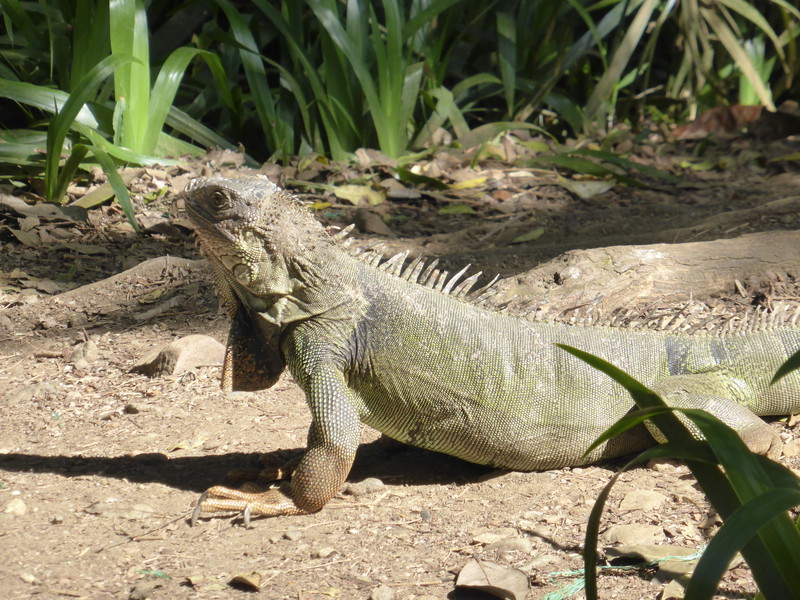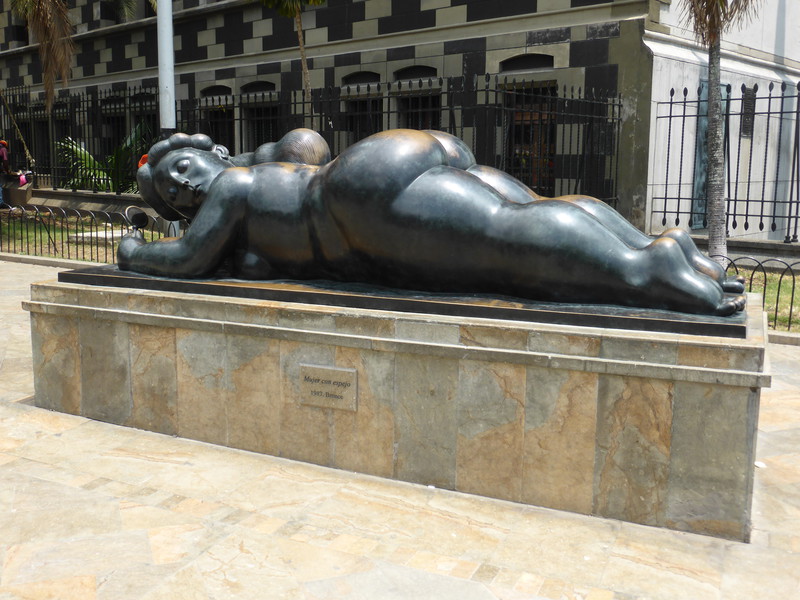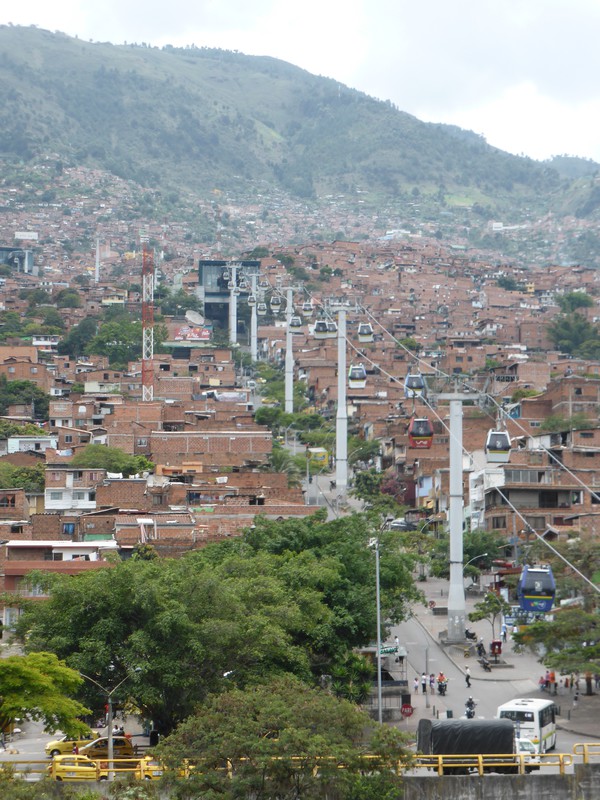
Just in case you were wondering, I can vouch that Medellín, Colombia's second-largest city, is a great place in which to feel absolutely terrible. If your insides have turned to jelly and you've got an itchy rash that you can't quite explain, then Medellín is a nice, comfortable place in which to get better.
For one thing, it has a pleasant climate; after the oven-like temperatures of Santa Marta and Cartagena, the perpetual spring climate of mountainous Medellín comes as a huge relief. It also has lots of restaurants covering all sorts of international cuisine, from Japanese to Peruvian to Thai to Argentinian to... well, possibly even Colombian, though with so many tempting options in the posh area of El Poblado, where we holed up, we didn't exactly go hunting for local cuisine. Oh, and Medellín has plenty of comfortable yet affordable hotels, particularly in the business district to the south of the centre, where there are even plenty of vacancies in Semana Santa (Holy Week), which is an extremely busy holiday in Catholic South America.
So if you wake up one morning, glance at each other and realise that you've both been struck down by something nasty, then Medellín is a good place to be. Just tuck yourselves up in bed, stick on the cable TV and give us a shout when you're better, because if there's one thing you can't do when you're travelling and you get ill, it's travelling.
Exploring Medellín

It was a shame that we got hit by the lurgy in Medellín, but you can't choose when you get ill, so we simply extended our stay and took our time while I drew a thick black line through all the things I'd pencilled in for the area. Bang went the Pablo Escobar tour, which was a shame as it's supposed to be a fascinating insight into the bad old days when, under Escobar's underground rule, Medellín was the cocaine and murder capital of the world; out went our planned day trip to the huge granite monolith at El Piedra del Peñol, which you can climb for amazing views of the surrounding countryside; and we waved goodbye to the long walks that I'd hoped we'd enjoy in the pleasant forests of Parque Arví, just out of town. Most annoying of all, we'd met a really friendly Englishman in Santa Marta called Patrick, who's lived in Colombia for a decade and has a pad in the countryside near Medellín, and he'd invited us to Sunday lunch at his house; but there was no way we were going to make it, and given that he has a nine-month-old baby who could probably live without being infected with a mystery illness, we sent in our apologies and hunkered down with the cold sweats instead.

But eventually we got well enough to get out of the hotel zone and see some of the city, mainly thanks to the city's excellent Metro. Our first tentative excursion was to the Jardín Botánico (botanical gardens) in northern Medellín, where the sun obligingly shone for us as we slowly wandered through the grounds of this pretty landscaped park. Given that it's surrounded by the city and is free to all visitors, it's a surprisingly rural experience, with huge iguanas climbing the trees and some intriguing buildings, including a butterfly house and an orchid garden that's tucked away under a huge wooden structure made up of towering hexagons. We had to keep stopping to catch our breath and hide from the hot sun, but there was plenty of shade and lots of people-watching on offer, so it was a good start.

Later on in our recuperative week, we visited the Plazoleta de las Esculturas and the adjoining Museo de Antioquia. Also known as Plaza Botero, this square contains 23 bronze sculptures by Fernando Botero, who is arguably South America's most famous contemporary artist; hailing from Medellín, Botero's style of sculpture and painting depicts people with exaggerated proportions, so his women are astonishingly voluptuous and his men are rounded and stocky. If you imagine taking a character from a Beryl Cook painting and inflating it with a bicycle pump, then you're not far off the look of a Botero, and they have the same playful but satirical air of Beryl Cook's work. Not surprisingly, they make excellent public sculptures, and the Plazoleta de las Esculturas is a great place to wander round.

It's also a great place for people-watching, not least because Colombia is the spiritual home of plastic surgery, and in particular the butt implant (or, to give the procedure its correct title, buttock augmentation). The proliferation of the butt-job in Medellín turns the Plazoleta de las Esculturas into a classic example of life imitating art, because while Botero's sculptured women have huge, voluptuous buttocks that defy gravity, so do an awful lot of the people in the plaza. Playing 'real or fake' is one of life's pleasures in this part of the world, and Plaza Botero is easily one of the best places to play it.

At the western edge of the plaza is the oldest museum in Medellín, the Museo de Antioquia; while it might not sound like it to English-speaking ears, this is a museum of modern art (Antioquia is the name of the Colombian department, of which Medellín is the capital). Modern art museums are always fascinating, not just because some of the art can be good, but because even when it appears to be rubbish, there's always fun to be had reading the explanatory notes that the museums provide. We've had endless fun traipsing round London's Tate Modern, trying to understand what on earth some of the descriptions are talking about, but in the Museo de Antioquia it's even more challenging, because the notes are in Spanish. One artist was so tortured that he came across as a real-life version of Brian from Spaced, with his three-screen full-room video installation showing him first writhing around half-naked and tied to a goat, then hand-wrestling a crab, and finally lying in a canoe with a large fish flopping on his crotch. The Spanish explanation of what this all meant didn't really help unravel the mystery of the installation, though I'm not sure our Español is quite up to explaining self-flagellatory hipster art.

Our final expedition in town was to Parque Arví, which you can reach via the Metro's cable car L. We chose a rather busy day to go exploring, and while queueing for the cable car, we discovered that the Colombians perhaps don't have the same attitude to personal space as we English do. If you have a backpack on, then the person behind you will keep on bumping into that pack, so much so that you start to get paranoid that they're rifling through it; so you switch the pack to your front, only to discover that the next stage is for the person behind to spoon you, right there in the queue. It's as if the entire city is up for a kind of super-intimate conga-line approach to queueing, and it came as a bit of a surprise as we waited for our turn in the cable car, sandwiched between the friendly locals.

In the end, Parque Arví wasn't really right for us, as it's full of activities that aren't suitable for those recuperating from illness; there are lots of walking trails on offer, but the nearest one to the cable car starts a steep 1km walk from the terminal, so it's not a good option for those looking for a gentle stroll. We thought we'd enjoy a picnic at the top, but there's precious little at the cable car terminus except lots of other people looking a bit lost and wondering where they can eat their sandwiches; there is a small lawn, but it's right by the vents to the composting toilet, so it's hardly prime real estate for potential picnickers. It's a bit of a missed opportunity, to be honest, but luckily the cable car journey itself is worth the effort, especially when it goes over the outer suburbs of the city, and you can peer down on the grittier parts of town from the safety of your little plastic bubble.

Oh, and if you're lucky, you too can get stuck in a cabin for the 15-minute return journey, with a man and his girlfriend and his phone playing super-irritating Spanish-language R&B. It's one of life's great pleasures, being unable to get away from someone else's awful music, and the Metro's cable car L is a great place to do it. I was tempted to grab his phone and perform a buttock augmentation right there and then, but to be honest, this is not the country – or the city – to try that sort of thing, so we left him to it and instead enjoyed our last night in Medellín with some Japanese cuisine and an early night, ready for our flight to Bogotá in the morning.